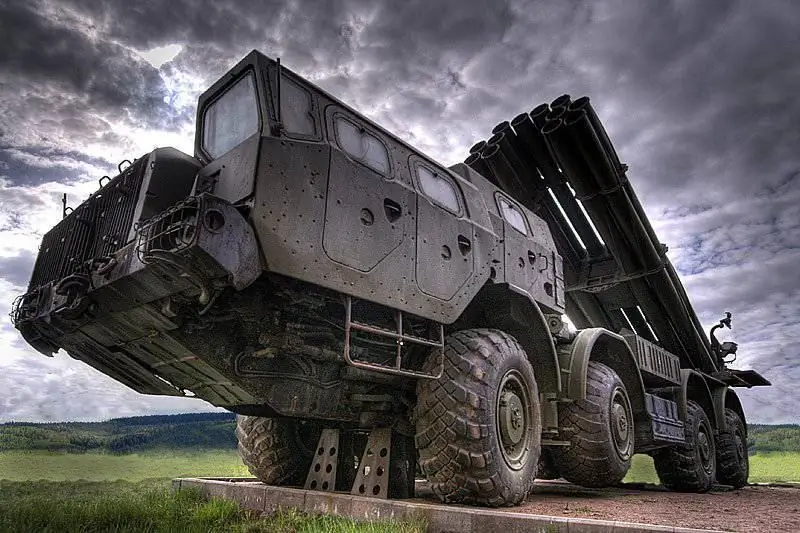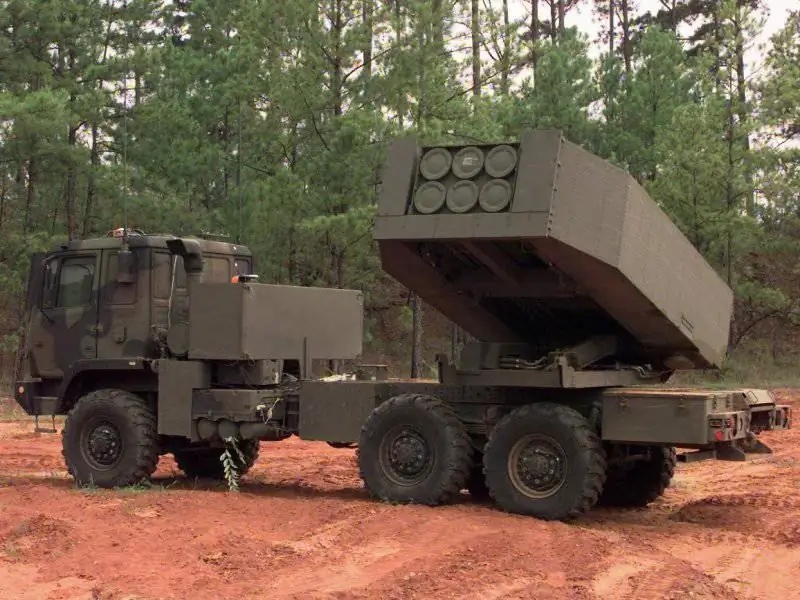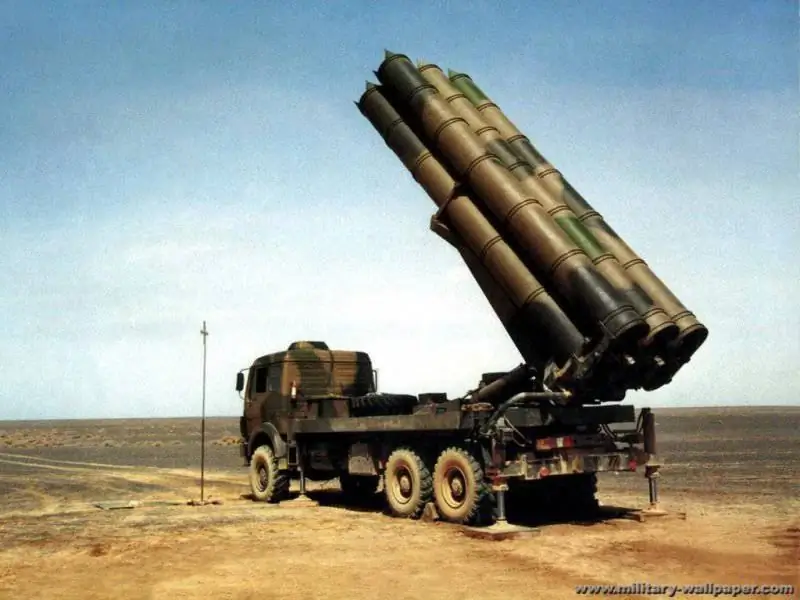- Author Matthew Elmers [email protected].
- Public 2023-12-16 21:49.
- Last modified 2025-01-24 09:17.
IA "Arms of Russia" proposed for consideration new ratings of military weapons and equipment, in which foreign and domestic samples of weapons participate.
At this hour, an assessment of the MLRS of different manufacturing countries has been carried out. The comparison was carried out according to the following parameters:
- the power of the object: caliber, range, area of action of one volley, time spent on firing a volley;
- object mobility: movement speed, travel range, full recharge time;
- operation of the facility: weight on alert, the number of combat and technical personnel, ammunition and ammunition.
The scores for each characteristic were given in the sum, the total score of the relay protection systems. In addition to the above, the temporal characteristics of production, operation and use were taken into account.
The following systems took part in the rating:
- Spanish "Teruel-3";
- Israeli "LAROM";
- Indian "Pinaka";
- Israeli "LAR-160";
- Belarusian "BM-21A BelGrad";
- Chinese "Type 90";
- German "LARS-2";
- Chinese "WM-80";
- Polish "WR-40 Langusta";
- Domestic "9R51 Grad";
- Czech "RM-70";
- Turkish "T-122 Roketsan";
- Domestic "Tornado";
- Chinese "Type 82";
- American "MLRS";
- Domestic "BM 9A52-4 Smerch";
- Chinese "Type 89";
- Domestic "Smerch";
- American "HIMARS";
- Chinese "WS-1B";
- Ukrainian "BM-21U Grad-M";
- Domestic "9K57 Hurricane";
- South African "Bataleur";
- Domestic "9A52-2T Smerch";
- Chinese "A-100".
After evaluating the participants in the rating, five MLRSs were identified that scored the highest number of points:
The leader of the top rating is the domestic system "Tornado"
Main characteristics of the system:
- ammunition caliber 122 mm;
- the total number of guides - 40 units;
- range of action - up to 100 kilometers;
- Affected salvo area - 840 thousand square meters;
- the time required to carry out a volley - 38 seconds;
- travel speed - 60 km / h;
- cruising range - up to 650 kilometers;
- the time required for the next volley - 180 seconds;
- standard calculation - three people;
- ammunition - three volleys.

The main developer is the Splav enterprise. Modifications - "Tornado-S" and "Tornado-G". The systems are designed to replace the Uragan, Smerch and Grad systems in service. Advantages - equipped with universal containers with the ability to replace the guides for the required caliber of ammunition. Ammunition options - caliber 330 mm "Smerch", caliber 220 mm "Uragan", caliber 122 mm "Grad".
Wheeled chassis - "KamAZ" or "Ural".
The Tornado-S is expected to have a stronger chassis soon.
MLRS "Tornado" - a new generation of MLRS. The system can start moving immediately after firing a volley, without waiting for the results of hitting the target, the automation of firing is performed at the highest level.
The second place in the top-ranking goes to the domestic MLRS 9K51 "Grad"
Main characteristics of the system:
- ammunition caliber 122 mm;
- the total number of guides - 40 units;
- range of action - up to 21 kilometers;
- Affected salvo area - 40 thousand square meters;
- the time required to carry out a volley - 20 seconds;
- travel speed - 85 km / h;
- cruising range - up to 1.4 thousand kilometers;
- the time required for the next volley - 420 seconds;
- standard calculation - four people;
- ammunition - three volleys.
- weight in readiness - almost 6 tons.

"9K51 Grad" is designed to destroy enemy personnel, enemy military equipment up to lightly armored, perform tasks of clearing the territory and providing fire support for offensive operations, and deterring enemy offensive operations.
Made on Ural-4320 and Ural-375 chassis.
She took part in military conflicts since 1964.
Delivered into service in many friendly countries of the Soviet Union.
The third place in the top ranking is occupied by the American system "HIMARS"
Main characteristics of the HIMARS system:
- ammunition caliber 227 mm;
- the total number of guides - 6 units;
- range of action - up to 80 kilometers;
- Affected salvo area - 67 thousand square meters;
- the time required to carry out a volley - 38 seconds;
- travel speed - 85 km / h;
- cruising range - up to 600 kilometers;
- the time required for the next volley - 420 seconds;
- standard calculation - three people;
- ammunition - three volleys.
- weight in readiness - almost 5.5 tons.

The High Mobility Artillery Rocket System is a development of the American company Lockheed Martin. The system is designed as an operational and tactical RAS. The beginning of the development of "HIMARS" - 1996. There are 6 MLRS missiles and 1 ATACMS missile on the FMTV chassis. Can use any ammunition from all United States MLRS.
Used in military conflicts (Operation Moshtarak and ISAF) in Afghanistan.
The penultimate place in this ranking is occupied by the Chinese system WS-1B
Main characteristics of the system:
- ammunition caliber 320 mm;
- the total number of guides - 4 units;
- range of action - up to 100 kilometers;
- Affected salvo area - 45 thousand square meters;
- the time required to carry out a volley - 15 seconds;
- travel speed - 60 km / h;
- cruising range - up to 900 kilometers;
- the time required for the next volley - 1200 seconds;
- standard calculation - six people;
- ammunition - three volleys.
- weight in readiness - just over 5 tons.

The WS-1B system is designed to disable critical facilities, such as military bases, concentration areas, missile launchers, airfields, important logistics hubs, industrial and administrative centers.
MLRS WeiShi-1B - modernization of the main system WS-1. Chinese army units still do not use this MLRS. WeiShi-1B is offered for sale on the arms market, the Chinese corporation CPMIEC is engaged in sales.
In 1997, Turkey purchased from China one battery of the WS-1 system, which contained 5 vehicles with MLRS. Turkey, with the support of China, organized its own production and delivered five more batteries of modernized MLRS to army units. The Turkish system gets its own name - "Kasirga". At present, Turkey manufactures the WS-1B system under license. This system received its own name "Jaguar".
The Indian Pinaka system completes the top rating of RPO systems
Main characteristics of the system:
- 214 mm ammunition;
- the total number of guides - 12 units;
- range of action - up to 40 kilometers;
- Affected salvo area - 130 thousand square meters;
- the time required to carry out a volley - 44 seconds;
- travel speed - 80 km / h;
- cruising range - up to 850 kilometers;
- the time required for the next volley - 900 seconds;
- standard calculation - four people;
- ammunition - three volleys.
- weight in readiness - almost 6 tons.

The Indian "Pinaka" is designed as an all-weather RPO system. Designed to destroy enemy personnel and enemy military equipment, up to lightly armored. It is possible to carry out tasks of clearing the territory and providing fire support for offensive operations and deterring enemy offensive operations. Can remotely establish minefields for enemy infantry and tank units.
It was used in the military conflict between India and Pakistan in 1999.






